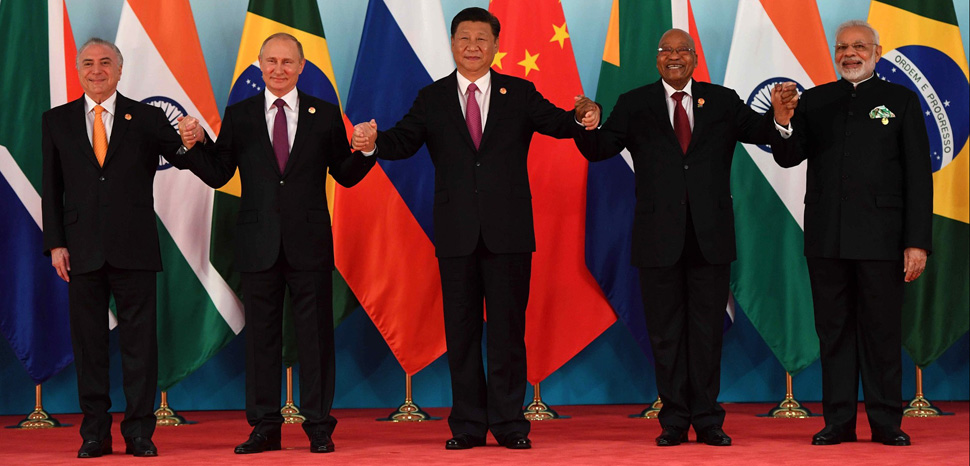…..Contd…….The recent political churning in Bangladesh has resulted in Mohammad Yunus, seen as being close to America, taking charge in Dhaka in an interim administration post Sheik Hasina exit, which is seen as proof of US handiwork. Yunus’ latest meeting with Bill Clinton and introducing the student leaders indicates his present strategic political maneuvers. Of course, China has welcomed the formation of the interim government headed by Yunus. Chinese diplomats attended the swearing-in ceremony. But, Chinese observers expect that the interim government may not last. They prefer Khaleda Zia to take the helm quickly. China is expected to gain big in Bangladesh given the latter’s $6billion debt.
Even the China-Maldives ties have improved with the election of Mohamed Muizzu as president in 2023. On March 5, 2024, the Maldives and China signed a bilateral military pact. President Mohamed Muizzu considers his country’s relationship with Beijing as one of the Maldives ‘closest’ allies and developmental partners in the region.
The Islamist Terrorist Groups are escalating crises proliferation aided abetted by the State actors and their colluding groups in India. Most importantly, the slow and steady demographic shifts – growth of Muslims and decline of Hindus- especially rapid in neighboring States of West Bengal, Assam, Bihar, and Jharkhand, prenominate dire forebodings in posterity.
In retrospect, the churning of India’s geo politics, both fallout ramifications of global and regional conflict escalation, cannot be avoided. Furthermore, the confrontation is real between Hindu-majority and Islamist States with Pakistan towards the West, Afghanistan towards the North and Bangladesh towards the East and separated by a crowded, common border. Also, the Islamist Radical Terrorists are in pursuit of establishing the Greater Islamic Caliphate in South Asia.
SINO INDIAN RELATIONS POST BRICS SUMMIT —POLITICAL POSTURING OR DIPLOMATIC GRANDSTANDING?
What has been achieved in the agreement preceding the Xi Jinping-Modi bilateral meeting reaffirmed “maintaining peace on the border (Line of Actual Control – LAC) should be our priority” and “mutual trust, mutual respect and mutual sensitivity should be the basis of our ties” may be viewed as political posturing or diplomatic grandstanding?
Even their reassertion that the Special Representatives on the India-China boundary question will meet at an early date to oversee the management of peace & tranquility in border areas and to explore a fair, reasonable and mutually acceptable solution to the boundary question and activation of the relevant dialogue mechanisms at the level of Foreign Ministers and other officials to be utilized to stabilize and rebuild bilateral relations follows the past scripted lines.
After the first informal Summit at Wuhan in April 2018, the two leaders “issued strategic guidance to their respective militaries to strengthen communication to build trust and mutual understanding and enhance predictability and effectiveness in the management of border affairs”. They also “directed their militaries to earnestly implement various confidence-building measures agreed upon between the two sides, including the principle of mutual and equal security, and strengthen existing institutional arrangements and information sharing mechanisms to prevent incidents in border regions”.
In retrospect, viewing the past agreements reached since 1988 and the border clashes that followed later, ensuring peace on the border based on mutual trust, mutual respect, and mutual sensitivity appears more of hype than reality, perhaps, a strategic retreat temporarily.

Let me briefly recall the past agreements. The first official bilateral administrative mechanism– the Joint Working Groups was announced on 23 December 1988 in a Joint Press Communiqué. The JWG held 15 meetings with the first meeting on 30 June to 4 July 1989 and the last meeting on 30-31 March 2005. Subsequently, the agreements reached to maintain the status quo include three Confidence Building Measures (CBMs) to include: 1993 – India-China Diplomatic and Military Expert Group: Border Peace and Tranquility Agreement along the LAC; 1996 – Agreement on Military CBMs; and 2005 – Protocol for the Implementation of Military CBMs along the LAC.
Furthermore, two political initiatives include the 2003- Special Representatives mechanism on the boundary question: Declaration on Principles for Relations and Comprehensive Cooperation that held 22 rounds of talks and continued; and the 2005 – Agreement on the Political Parameters and Guiding Principles for the Settlement of the India-China Boundary Question.
Add to them, agreements that followed include: 2012 – Agreement on the Establishment of a Working Mechanism for Consultation and Coordination on India-China Border Affairs that had 20 rounds of talks and continuing; 2013 – Border Defense Cooperation Agreement; and 2020 – 5 point statement. Over 22 rounds of Corps commander-level talks have not yielded results.
A pragmatic review of the patrolling arrangement along the LAC and the two leader’s reiteration of “maintaining peace on the border (Line of Actual Control – LAC) should be our priority” and “mutual trust, mutual respect, and mutual sensitivity should be the basis of our ties as a significant breakthrough after 2020 is most critical. All one can hope for the best is the lowering of tensions on the LAC in the short and midterm contexts.
The agreement announced before the bilateral meeting broadly highlighted the following: “De-escalation by disengagement”; “Stabilization” particularly reducing confrontations at friction points such as Depsang Plains and Demchok; “Stability” along LAC that may foster a better environment for broader negotiations on boundary issues; “Confidence-building” by resumption of patrolling as per pre-2020 terms that indicates a mutual willingness on both sides to return to a status quo that they found ac- acceptable before the recent tensions paving the way for further dialogue; and “Political Implications” to enhance bilateral relations that might facilitate higher-level diplomatic interactions.
After the bilateral meeting, the two leaders affirmed that stable, predictable, and amicable bilateral relations between India and China, as two neighbors and the two largest nations on earth, will have a positive impact on regional and global peace and prosperity. It will also contribute to a multi-polar Asia and a multi-polar world. The leaders underlined the need to progress bilateral relations from a strategic and long-term perspective, enhance strategic communication, and explore cooperation to address developmental challenges.
Be that as it may, the resolution of the India-China border disputes is extraordinarily complex. Most important to note that the LAC/border was never ratified by any treaty and demarcated on the ground. The British defined the border under two lines: the Johnson Line of 1865 (Akshai Chin in Indian Territory); and the McCartney–MacDonald Line of 1899. India’s claim line is the Johnson Line which includes the Akshai Chin. But, the Chinese claim the LAC including the Akshai Chin. Between the disastrous 1962 war and the mid-1970s, India withdrew forces from the LAC.
In 1976, the China Study Group decided that India needed to police the LAC all over again. 65 Patrolling Points (PPs)” define the limits of patrolling as approved by Indira Gandhi. The PPs are mainly bang on the LAC, except in the Depsang Bulge (PP10 -13) where they are located a little short of it. The PPs within the LAC and the patrol routes that join them are known as ‘limits of patrolling’. The various patrol routes to the limits of patrolling are called the ‘lines of patrolling’.
Some of the irrefutable facts of loss of territory during the Congress Party rule include Aksai Chin (37,244 square km) pre 1962;Tia Pangnak and Chabji Valley (250m length) in Chumur area till 2008; Zorawar Fort in Demjok was destroyed by PLA in 2008 and setup PLA’s Observing Point in 2012 during UPA regime and creating New Demjok Colony with 13 cemented houses; and India lost Doom Cheley between Dungti and Demjok in 2008-2009.
History in Outline
Defining historic milestones include: 1) In 1834, Raja Gulab Singh’s (Dogra) armies under the suzerainty of the Sikh Empire conquered Ladakh; 2) In 1842, following an unsuccessful campaign into Tibet, Gulab Singh
and the Tibetans signed a treaty in 1842 agreeing to stick to the “old, established frontiers”, which were left unspecified; 3) In 1846, following the victory of the British over the Sikhs, J & K region including Ladakh was transferred and Gulab Singh was installed as the Maharajah under the British suzerainty; and 4) the Maharaja regarded Shahidulla as his northern outpost, in effect treating the Kunlun mountains as the boundary of his domains. Also, Chinese Turkestan regarded the “northern branch” of the Kunlun range with the Kilian and Sanju passes as its southern boundary.
When Chinese officials were contacted by the British, they did not show any interest in negotiating the border. So, the British boundary commissioners fixed the southern end of the boundary at Pangong Lake but regarded the area north of it till the Karakoram Pass as terra incognita. In 1865, W. H. Johnson who was commissioned to survey the Aksai Chin region drew the line stretching from Sanju Pass to the eastern edge of Chang Chenmo Valley along the Kunlun Mountains, which is referred to as the “Johnson Line”.
By 1892, the British settled their preferred boundary for Kashmir as the “Indus watershed”, i.e., the water-parting from which waters flow into the Indus river system on one side and into the Tarim basin on the other. In the north, this water parting was along the Karakoram Range. In the east, it was more complicated because the Chip Chap River, Galwan River, and the Chang Chenmo River flow into the Indus whereas the Karakash River flows into the Tarim basin.
In 1893, Hung Ta-chen handed over the Chinese Map to the British consul at Kashgar. The boundary, marked with a thin dot-dashed line, agrees with the 1878 British map. It showed the boundary of Xinjiang up to Raskam. In the east, it was similar to the Johnson line, placing Aksai Chin in Kashmir territory.
In 1899, the British government proposed to China via its envoy Sir Claude MacDonald, which came to be called the McCartney–MacDonald Line, cede to China the Aksai Chin plains in the northeast, and the Trans-Karakoram Tract in the north. In return, the British wanted China to cede its ‘shadowy suzerainty’ on Hunza.
In the year 1913, the United Kingdom (UK), China, and Tibet met at Shimla to sign an agreement on the alignment of the international boundary as per the map produced by the Foreign Department of British India. Though China initialed on the proposal, later they backed off citing ambiguities and technical reasons. Henry McMahon, the Foreign Secretary, who had drawn up the proposal, then decided to bypass the Chinese and settle the border bilaterally by negotiating directly with Tibet. China, however, rejected Tibet’s claim of independent rule and maintained that the said treaty had no sanctity without China’s endorsement.
To highlight, the Ardagh–Johnson Line as per British Indian Government, was considered as a formal pro- posed traditional boundary of the State of Jammu & Kashmir with Xinjiang and Tibet. Aksai Chin was, therefore, claimed by India to belong to Kashmir. By the end of World War I, the British officially used the Johnson Line. (to be concluded)





